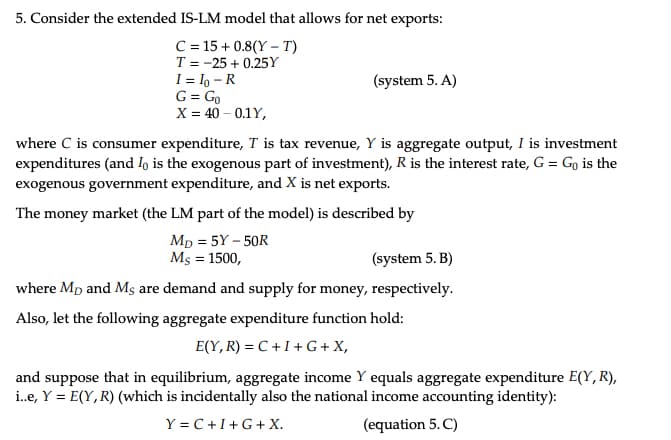5.1. Using system 5. A and equation 5. C, derive the IS curve (Hint: You would effectively derive a linear expression for Y in terms of Go, Io, and R. No need to use linea algebra for this item.). 5.2. Using system 5. B, derive the LM curve (Hint: You would effectively derive linear expression for Y in terms of R. No need to use linear algebra for this item.). 5.3. Construct a linear system of two equations based on your answers in items 5. and 5.2 (Please place all expressions with Y and R on the left-hand side.). 5.4. Transform the system you constructed in item 5.3 into a matrix equation Ax = b = []; and then find the equilibrium values Y* and R* using matrix inversion. with x =
5.1. Using system 5. A and equation 5. C, derive the IS curve (Hint: You would effectively derive a linear expression for Y in terms of Go, Io, and R. No need to use linea algebra for this item.). 5.2. Using system 5. B, derive the LM curve (Hint: You would effectively derive linear expression for Y in terms of R. No need to use linear algebra for this item.). 5.3. Construct a linear system of two equations based on your answers in items 5. and 5.2 (Please place all expressions with Y and R on the left-hand side.). 5.4. Transform the system you constructed in item 5.3 into a matrix equation Ax = b = []; and then find the equilibrium values Y* and R* using matrix inversion. with x =
Chapter8: Aggregate Demand And Aggregate Supply
Section: Chapter Questions
Problem 7QP
Related questions
Question
answer 5.3 & 5.4

Transcribed Image Text:5. Consider the extended IS-LM model that allows for net exports:
C=15+0.8(YT)
T-25 +0.25Y
I= 10-R
G = Go
X = 40 -0.1Y,
(system 5. A)
where C is consumer expenditure, T is tax revenue, Y is aggregate output, I is investment
expenditures (and Io is the exogenous part of investment), R is the interest rate, G = Go is the
exogenous government expenditure, and X is net exports.
The money market (the LM part of the model) is described by
MD = 5Y-50R
Mş = 1500,
(system 5. B)
where Mp and Ms are demand and supply for money, respectively.
Also, let the following aggregate expenditure function hold:
E(Y, R)=C+I+G+ X,
and suppose that in equilibrium, aggregate income Y equals aggregate expenditure E(Y, R),
i..e, Y = E(Y, R) (which is incidentally also the national income accounting identity):
Y=C+I+G+ X.
(equation 5.C)
![5.1. Using system 5. A and equation 5. C, derive the IS curve (Hint: You would
effectively derive a linear expression for Y in terms of Go, Io, and R. No need to use linear
algebra for this item.).
5.2. Using system 5. B, derive the LM curve (Hint: You would effectively derive a
linear expression for Y in terms of R. No need to use linear algebra for this item.).
5.3. Construct a linear system of two equations based on your answers in items 5.1
and 5.2 (Please place all expressions with Y and R on the left-hand side.).
5.4. Transform the system you constructed in item 5.3 into a matrix equation Ax = b,
= []; and then find the equilibrium values Y* and R* using matrix inversion.
with x =](/v2/_next/image?url=https%3A%2F%2Fcontent.bartleby.com%2Fqna-images%2Fquestion%2F0ed9542f-d658-47ef-8561-8166da0af35e%2Faf1cf20b-aae0-4fbd-92ed-e9895fafff4c%2F6hf9z02_processed.jpeg&w=3840&q=75)
Transcribed Image Text:5.1. Using system 5. A and equation 5. C, derive the IS curve (Hint: You would
effectively derive a linear expression for Y in terms of Go, Io, and R. No need to use linear
algebra for this item.).
5.2. Using system 5. B, derive the LM curve (Hint: You would effectively derive a
linear expression for Y in terms of R. No need to use linear algebra for this item.).
5.3. Construct a linear system of two equations based on your answers in items 5.1
and 5.2 (Please place all expressions with Y and R on the left-hand side.).
5.4. Transform the system you constructed in item 5.3 into a matrix equation Ax = b,
= []; and then find the equilibrium values Y* and R* using matrix inversion.
with x =
Expert Solution
This question has been solved!
Explore an expertly crafted, step-by-step solution for a thorough understanding of key concepts.
Step by step
Solved in 4 steps with 4 images

Knowledge Booster
Learn more about
Need a deep-dive on the concept behind this application? Look no further. Learn more about this topic, economics and related others by exploring similar questions and additional content below.Recommended textbooks for you


Economics (MindTap Course List)
Economics
ISBN:
9781337617383
Author:
Roger A. Arnold
Publisher:
Cengage Learning


Economics (MindTap Course List)
Economics
ISBN:
9781337617383
Author:
Roger A. Arnold
Publisher:
Cengage Learning